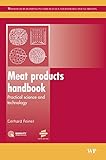Meat products handbook: practical science and technology
Publication details: Cambridge, Woodhead Publishing, 2006Description: 648pISBN: 9781845690502Subject(s): Meat and livestock industry | Meat processing | Meat products | Food prices | Meat quality | Food safety | Packaging | Hazard analysis | MicrobiologyLOC classification: TX556.M4Online resources: Click here| Item type | Current library | Call number | Copy number | Status | Date due | Barcode |
|---|---|---|---|---|---|---|
| Book - Standard loan | CAFRE Loughry Library | TX556.M4 FEI (Browse shelf(Opens below)) | 1 | Available | 190407 |
PART 1 MEAT COMPOSITION AND ADDITIVES The protein and fat content of meat - Amino acids, Proteins, Collagen, Muscle physiology,Flavour of meat, Principles of muscle contraction and relaxation, Enzymes in meat, Fat, Rancidity of fat, LDL- and HDL cholesterol, Nutritional value of meat and other protein rich food The biochemistry of meat - Biochemical processes in meat pre-slaughter, Biochemical processes in meat post-slaughter (rigor mortis) The tenderness of fresh meat - Ageing of meat to enhance tenderness, Enzymes used to enhance the tenderness of meat Definitions of terms used in meat science and technology - PSE/RSE/DFD- and ?normal? meat, MDM/MSM meat, Hot boning of meat ? ?Warm meat effect?, Thaw rigor, Cold shortening, Electrical stimulation, Freezing and thawing of meat Freezer-burning, pH-value, Aw-value (water activity) Eh-value (redox potential) Condensation water, Maillard reaction, Caramelization, Conductivity of meat Additives: phosphates, salt (sodium chloride) and hydrocolloids - Phosphates, Salt - sodium chloride, citrate, lactate, Hydrocolloids Additives: proteins, carbohydrates, fillers and other additives - Proteins, Carbohydrate, Fillers: Maltodextrine, Flour, Wheat fiber, Konjac, Cereal binder, Rusk- Preservatives in meat products- Mono-Sodium-Glutamate (MSG- Ribonucleotide and other flavour enhancers- Water- Spices and spice extracts - Hydrolysed Vegetable Protein (HVP)- Antioxidants- Natural smoke - Liquid smoke- Colours in meat products- Whitening (bleaching) of meat - Glucono-delta-lactone (GDL) - Citric acid- Emulsifiers in meat products - Alginate for reformed meat- Enzymes for reformed meat and other meat products - Blood derived products for reformed meat- Allergy risks from additives in meat Colour in fresh meat and cured meat products - Retention of colour in fresh meat and uncured meat products- Nitrite and nitrate - Mechanism of colour development in cured meat products- Colour enhancers - Measuring colour: the L*-, a*- and b - -system PART 2 TECHNOLOGIES FOR PARTICULAR MEAT PRODUCTS Cooked ham: whole muscle, brine-injected products - Selection and preparation of raw materials- Selection of additives - Calculating brine composition and injection levels- Manufacturing technology - Summary of critical production issues Typical whole muscle, brine-injected cooked ham products from around the world - Bacon (Australia)- Bacon (New Zealand)- COB ham (cooked-ham-on-the-bone) (Australia)- Champagne-Ham (Australia)- Master-Ham (Austria)- Kasseler (Austria, Germany)- Virginia Ham (Australia)- Bacon (England) - Bacon (USA)- Pastrami (USA and Australia)- Roast Pork (Australia)- Beef bacon Cooked ham: non-injection methods for adding brine - Selection and preparation of raw materials- Selection of additives- Manufacturing technology- Summary of critical production issues Typical cooked ham products from around the world using non-injection methods for adding brine - Sandwich-Ham (Australia)- Chicken-Loaf (Worldwide)- Delicates-ham (Austria) Cooked sausages - Selection of raw materials- Production and use of pork or chicken skin emulsion in cooked sausages- Production and use of fat emulsion in cooked sausages- Selection of additives- Manufacturing technology- Summary of critical production issues Typical cooked sausage products from around the world Fresh sausages Typical fresh sausage products from around the world Raw fermented salami Typical raw fermented salami products from around the world Semi and fully-cooked fermented salami Non-fermented salami Typical non-fermented salami products from around the world Spreadable raw fermented sausage Typical raw fermented sausage products from around the world Cured air-dried meat products Typical cured air-dried meat products from around the world Spreadable liver sausage and liver-pâté Typical liver sausage and liver-pâté products made around the world Burger, patties and crumbed products Typical patty and nugget products from around the world Sliceable and non-sliceable blood sausage Typical blood sausage products from around the world Brawn and meat jelly Typical brawn and meat products from around the world Canned retorted corned beef Moisture-enhanced (case-ready) and marinated meat Casings and packaging material PART 3 QUALITY AND SAFETY ISSUES Sensory evaluation of meat products HACCP in meat processing companies The microbiology of meat and meat products The microbiology of specific bacteria
The first part of the book reviews meat composition and its effect on quality together with the role of additives. There are chapters on fat, protein and other components in meat, changes in meat pre- and post-slaughter, and additives such as phosphates, salts, hydrocolloids, proteins, carbohydrates and fillers. Part two reviews raw materials, additives, manufacturing processes and representative recipes from around the world for a range of particular meat products. It includes chapters on cooked ham and bacon, cooked, fresh and raw fermented sausages, raw fermented and non-fermented salami, cured air-dried products, burgers and patties, brawn and meat jelly, canned and marinated meat. The final part of the book discusses quality and safety issues, particularly meat microbiology.


There are no comments on this title.